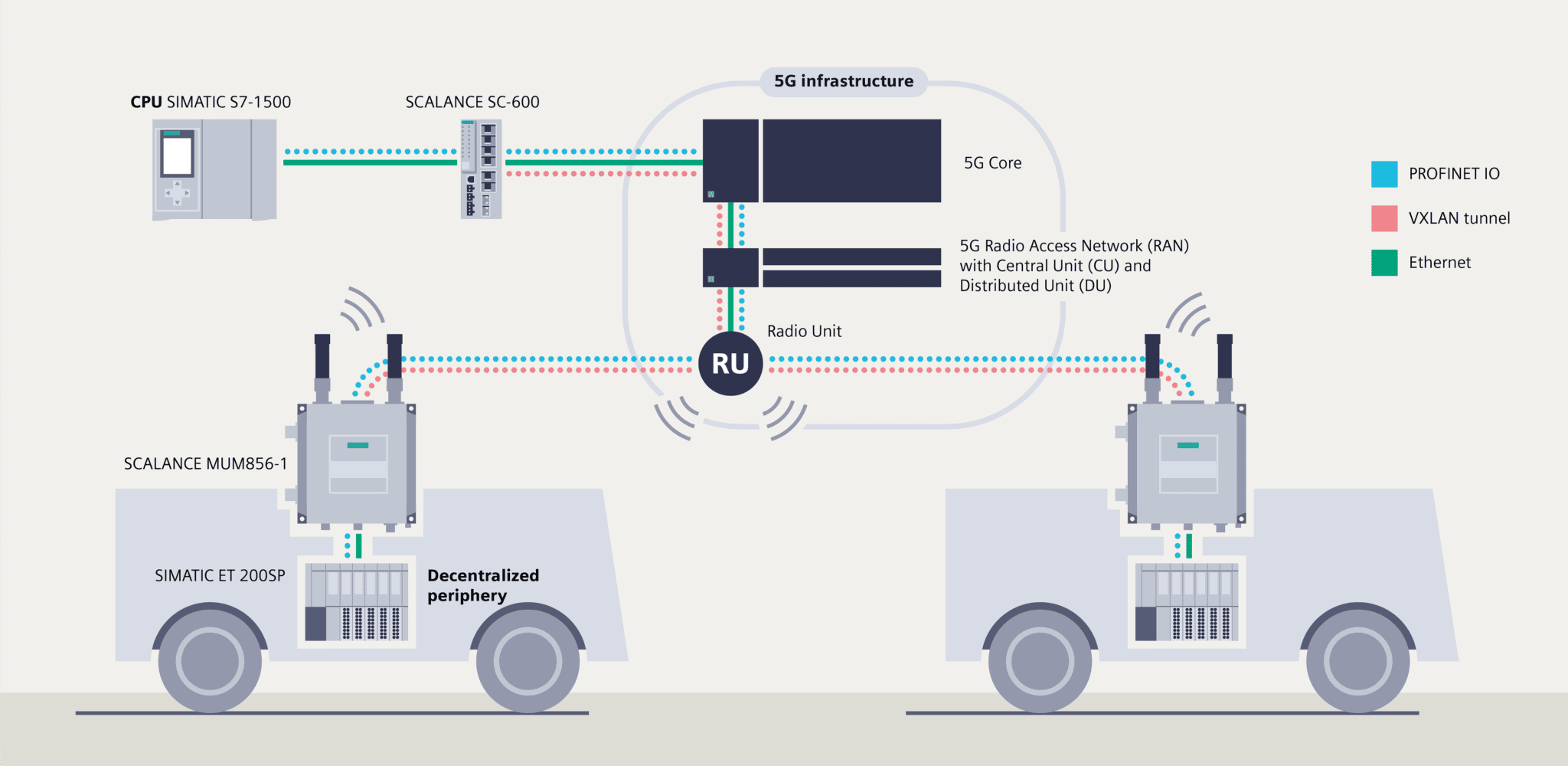If you wanted a signpost to where industrial 5G is today, you could do worse than consider a couple of pre-Hannover Messe announcements, from Nokia about integrating Wi-Fi into its private 5G system, and from Siemens, detailed below, about integrating layer-two Profinet comms into its industrial 5G devices. These press salvos (along with recent news from Nokia/Kyndril and NTT/Schneider Electric about scaling private 5G into multi-site multi-market factory deployments) tell you where the market is: getting its house in order, and grasping at some kind of maturity.
German industrial juggernaut Siemens has said its prototype private 5G system – incorporating Siemens-made Release 15-level 5G NR core and 5G NR radios, and first trailed in Enterprise IoT Insights a year ago – will be ready for commercial launch in 2023. The likelihood is it will be debuted in full at Hannover Messes 2023. But the firm is offering a preview at this year’s show, in combination with fairground operator Deutsche Messe; the pair are inviting companies to test (and delegates to see) industrial IoT apps on the setup, running in the local 3.7-3.8 GHz band.
More significantly, in real terms, Siemens (like Nokia, also) is talking industrial-grade Release 15 devices for Industry 4.0, and has just announced support for Profinet (a portmanteau of process-field-network, commonly stylised as PROFINET), the popular layer-two protocol for time-constrained two-way comms between SCADA systems and industrial machines, in its Scalance MUM853-1 industrial 5G routers. It might sound like minor technical philandering, but the move represents an important consummation of cellular’s entry into the industrial domain.
Siemens reckons no other industrial 5G device, as yet, makes support for layer-two connectivity – which is the only way industrial machines will communicate deterministically over 5G networks, and therefore the only way ultra-reliable (URLLC) 5G networks will bring order and control to smart factories – available off-the-shelf. Everything else, it implies, requires some kind of workaround, either by retro-engineering the same Virtual Extensible LAN (VXLAN) trick that Siemens is offering out-of-the-box, or via some other “classic VPN tunnel”.
The firm said it has integrated VXLAN as a transmission technology into its Scalance MUM853-1 series, plus some unspecified “security appliances” from Siemens; the result is VXLAN embeds “real-time” layer-two Profinet comms into layer-three 5G data packets, it said. A statement said: “Since layer-two communication now takes place via 5G, a central controller can communicate with decentralized I/O modules on mobile devices such as AGVs via Profinet in a private 5G network and no local controls have to be used on the individual AGVs.”

Siemens will show Profinet-connected automated guided vehicles (AGVs) running over its private 5G system at the 5G-ACIA stand in Hall 9 at Hannover Messe (May 30-June 2). The point, it implies, is to bring high-fidelity control to industrial systems, such as fleets of networked AGVs on factory floors – and not best-effort 5G comms without Profinet-grade determinism, as with standard trials of 5G-geared AGVs in factories so far. “The Scalance MUM853-1 thus enables trend-setting applications such as mobile robots in production or AGVs in logistics,” said Siemens.
Subscribe now to get the daily newsletter from RCR Wireless News
The new Scalance 5G router – announced late-2020, launched mid-2021, and still a Release 15 unit – offers remote management and control of industrial machines and devices via either public or private LTE and 5G. Profinet, for its part, is a key layer-two protocol for industrial networking, standardised over Ethernet. It is Siemens’ favourite; the one it promotes. But it is not the only one, clearly: the likes of Ethercat, Ethernet/IP, Modbus/TCP, Sercos III, CC-Link are also well-used. Nokia is expected to announce layer-two compatibility across the board at Hannover Messe.
The issue with industrial 5G, currently, is it is fixed at Release 15 of the 5G NR standard, which does not contain the URLLC features that allow for layer-two data packets to be transmitted over the layer-three cellular infrastructure, and will only be available with Release 16, and on. Writing in a blog, Lars Walpurgis, product owner for industrial 5G routers and SINEMA remote connect at Siemens, explains: “Companies are… faced with a challenge since the current Release 15 infrastructure cannot transmit the Layer 2 communication.”
He goes on: “Only the layer above, Layer 3, is supported. This makes it possible to [do]… web-based [device] management, or… OPC UA or MQTT…. [But] Profinet cannot be used natively because it requires a Layer 2 connection, only be supported in… Release 16. However, Profinet can be used… by using the VXLAN protocol… [which] in simplified terms embeds the logical Layer 2 communication in Layer 3 packets. This makes it possible to transmit Layer 2 protocols transparently across network boundaries, such as in routed Layer 3 5G infrastructures.
“This approach opens up completely new possibilities. For example, several AGVs can be controlled centrally with one SIMATIC controller. Profinet is used… between the [controller] and the distributed I/O devices on the AGV. At the heart of [it] is a… Release 15 5G infrastructure to which the routers are connected… The special feature of this network… is a VXLAN tunnel between the router and firewall, placed between the controller and the 5G core. The two devices encapsulate and decapsulate the PROFINET packets with the aid of VXLAN.
“[This enables] wireless Profinet… between the controller and the distributed I/O devices… This ‘tunnel’ should not be confused with classic VPN tunnels, since no additional encryption is performed here by the VXLAN protocol – only the encapsulation of the packets. By means of the VXLAN tunnel, the AGVs network with the [I/O devices] and the controller are in the same virtual Layer 2 network and, for the first time, the Profinet protocol… can be used for the communication over a 5G network.”
Walpurgis makes the point that Profinet “update times and retransmission repetitions” are pegged to the performance of the 5G network, and the release version in play. “As 5G releases progress, the performance will continue to improve with, for example, URLLC extensions,” he says.

